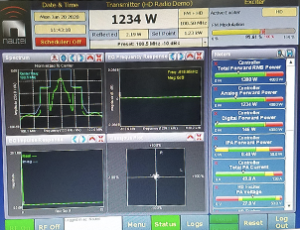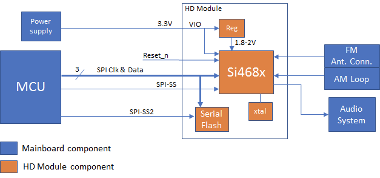HD Radio: India News Edition April 2020
Xperi’s Technology Update: HD Radio Testing in Delhi
The HD Radio™ digital FM broadcast system has been tested in New Delhi, India. The HD Radio team set up transmission on 100.5MHz at All India Radio’s Akashvani Bhawan transmission tower in New Delhi. The digital FM broadcast has been operating in a simulcast mode (hybrid operation of analog and digital) since January 13, 2020.
The HD Radio team has worked with ComCon and Nautel to provide test support to All India Radio research teams during this evaluation phase. The team has completed significant number of tests to evaluate the digital radio coverage, digital audio quality, and interference.
The HD Radio broadcast is transmitting utilizing a Nautel VS2.5 transmitter operating at 1.2kW power with 1000 watts devoted to analog transmission and 100 watts devoted to digital transmission. The transmitter feeds a 4-bay Jampro antenna side-mounted at 78m AGL on a wide cross-section transmission tower. Due to tower reflections, the antenna pattern is highly directional toward the southwest with significant signal reduction toward the northeast.

With 100 watts of digital power, the transmission covers the metro Delhi area with reception range of 18 – 20 km. The coverage measurements were made at various stationary intervals test points. At each measurement point, the test tools recorded the GPS coordinates, signal strength, digital signal availability, and captured the RF spectrum.

The testing highlights the benefits of HD Radio including 4 digital audio programs simulcasting with analog, program service data, album images, station logos, and emergency alert capability. Many commercial receiver products were used in the field test. These products demonstrated the capability of consumer-grade receivers for the general public.
Overall, the HD Radio trials and testing in New Delhi was very successful. We look forward to additional tests and demonstrations in India.
FCC Notice for Proposed Rulemaking on All Digital AM
The FCC issued a Notice for Proposed Rule Making in November 2019 to modify the rules allowing for voluntary adoption of AM All Digital (MA3 operations) and to codify NRSC-5 standard into the FCC rules. The move was initiated by a petition from Bryan Broadcasting in March 2019 to initiate FCC action to ease the rules and implement policy to all for stations to voluntarily convert their analog transmission to digital-only transmission.
WWFD (820kHz – Frederick, MD) was the first station to transition to a digital-only for an extended time-period. The data provided by WWFD and test reports from the National Association of Broadcasters provided a substantial public record of all digital MA3 mode operations.
Permitting stations to broadcast in all-digital MA3 mode will advance the industry desire to revitalize the AM service, expanding the types of programming available in the band and the overall utility of AM stations. Stations transmitting in all-digital MA3 mode will provide a more listenable signal at lower signal strengths. All-digital signals also provide a better overall listener experience, with improved audio quality (comparable to analog FM quality) and the elimination of audio static that plagues analog AM signals. AM stations broadcasting in all-digital mode can also supplement aural services with song and artist identification, traffic and weather information, and visual emergency information. And all-digital AM stations are more spectrally efficient than their hybrid counterparts, focusing core program content in the center of the signal rather than on sidebands.
By allowing AM stations to transition to all-digital on an entirely voluntary basis, the FCC will allow each broadcaster to weigh the benefits and risks associated with transitioning a particular station at any given time.
Since HD Radio technology was introduced in North America, more than 70 million receivers have shipped to date. Consumer HD Radio receivers have been available since 2005. As broadcaster and consumer interest in digital broadcasting has grown, prices have consistently decreased. Today, HD Radio receivers for home and portable use are available nationwide for as little as $49.99, and aftermarket products for retrofitting existing car radio systems are available for as little as $119.00.
Now is the time to move toward a digital sunrise.
Xperi Announces New HD Radio Module
Xperi Corporation has designed a new HD Radio module (HDR-3458) for audio and data applications. The module is based on Silicon Labs Si468x digital radio chipset. Designed for AM & FM applications, the module can be easily integrated into portable radio tuners (audio applications), emergency warning products (safety and public service), or IoT devices (data applications).

The module measures 23.88mm x 17.91mm. With minimal hardware, the radio function in this module design is self-contained for easy integration into radio applications.
- Single 3.3V supply.
- Onboard serial flash.
- Onboard core voltage regulator
- Si468x HD Radio chipset

HD Radio Emergency Alerts protocols enable enhanced alerting systems with multimedia, improve geographic targeting, and enhance resiliency and redundancy for greater accessibility of alert information.
During times of emergency cellular services are less reliable due to the high use of the network. Radio broadcast has historically been the main reliable communication of alerts and announcements. The HD Radio digital emergency alert service should be utilized as an integral part of the collaborative effort to upgrade the nation’s public alerting capabilities. With HD Radio Emergency Alerts, federal, state, local, and tribal authorities can greatly improve the nature and quality of their critical efforts to notify the public of Presidential directives, national security alerts, AMBER alerts, weather-related events and other emergency situations. Radio broadcasters can utilize the audio and data channels of their HD Radio signal to send various enhanced alert information, including text notifications, image data and location information, and multilingual announcements.
The HDR-3458 module supports this life-saving notification service and can be integrated into consumer and professional safety devices.
HD Radio system enables a wireless data transmission network utilizing existing broadcast infrastructure in all major markets. With the digital data services from HD Radio, content providers can take advantage of the benefits of one-to-many broadcast service to provide command/control messaging, configuration updates, and even software updates to millions and billions of devices at a fraction of the cost of cellular services. The HDR-3458 module can be integrated into IoT devices and applications to take advantage of the HD Radio data network for future product and IoT applications.
The module bill of materials is under $5.00US in 10k piece quantity. Further cost reductions are achieved in larger production volumes.



For more information, please contact Ashruf El-Dinary, Senior Vice President of Radio Applications (ashruf.el-dinary@xperi.com ).

